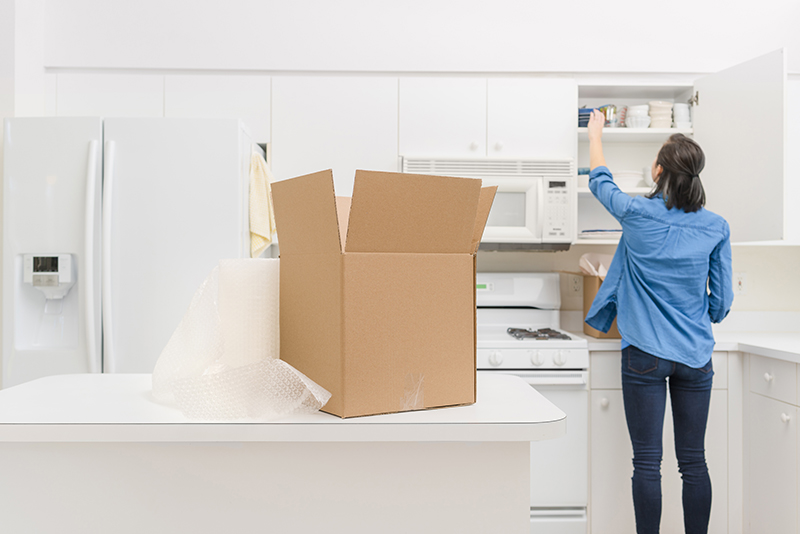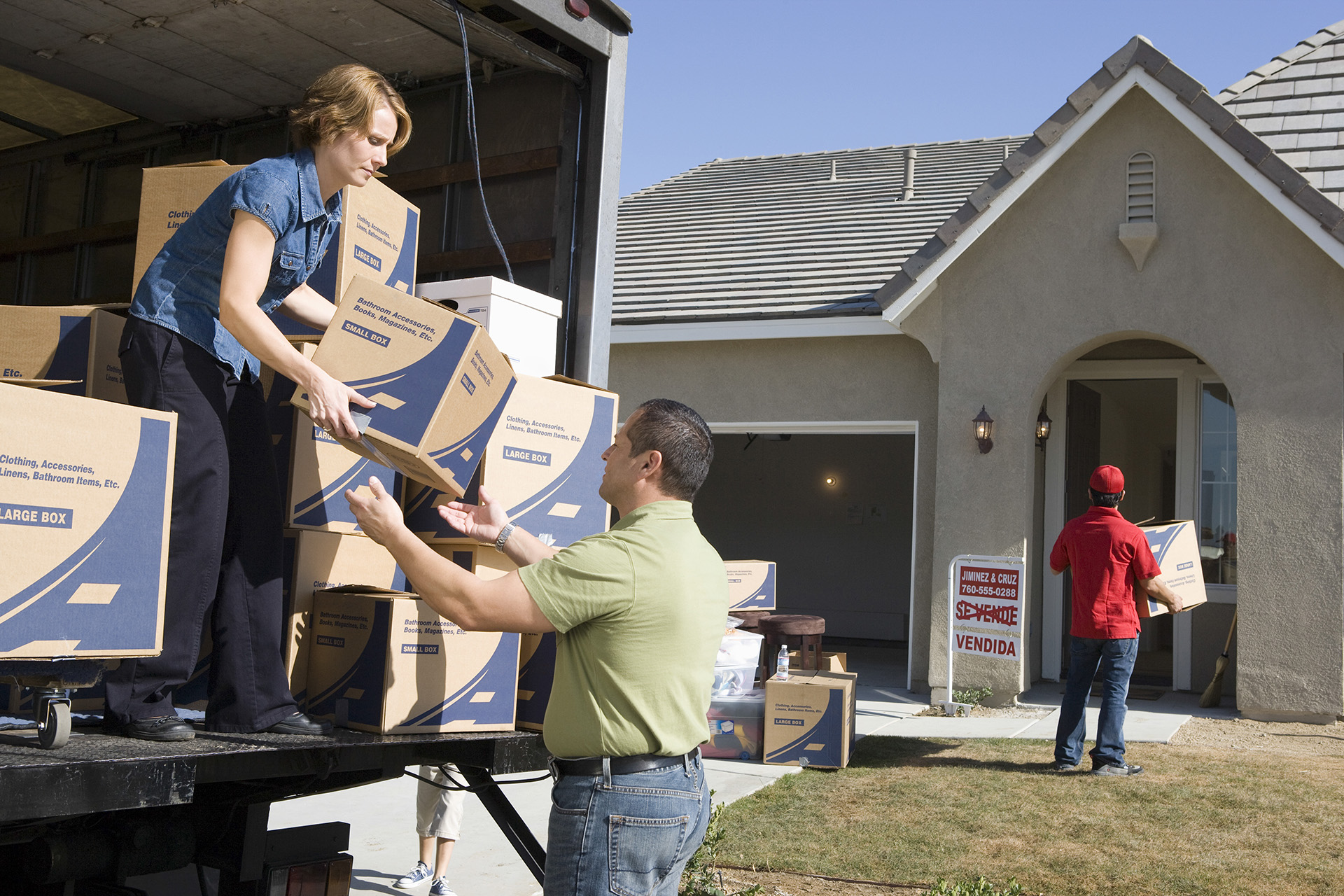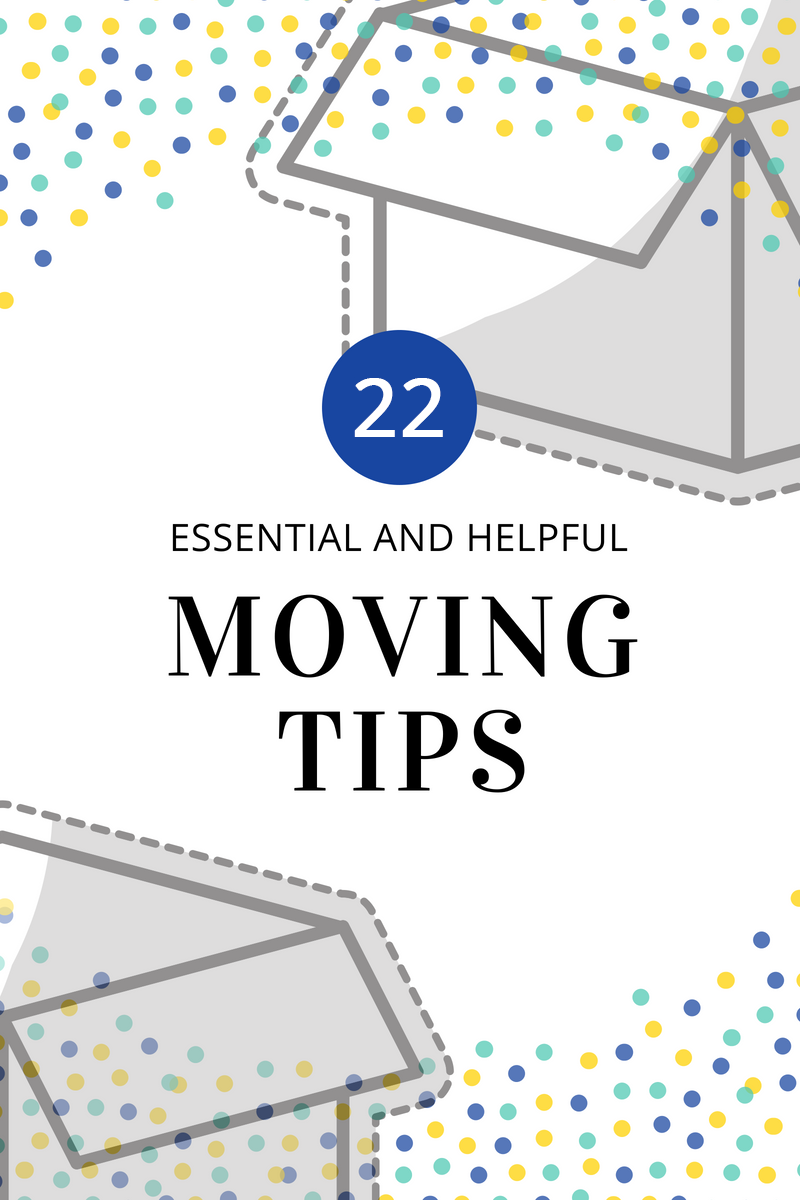Do you want to know how to pack for a move as fast as possible? Are you interested in ways you can make relocating more manageable and less stressful? If that’s the case, we’ve got you covered with a roundup of our best packing and moving tips. They might just alter the way you approach moving for the better!
Take some time out to familiarize yourself with these simple but effective moving day tips, organization ideas, and packing tips for moving:
Easy Moving Tips: Preparing for a Move

1. Create a moving checklist and timeline.
Before you even begin preparing for your move, it’s a good idea to draft a moving checklist with a rough timeline. Of course, everyone’s timeline will look slightly different depending on factors like your reason for relocating, how much notice is given before the move, and how far you’ll be moving. Some people will have two months, and others might have two weeks. In any case, you can work backward from your move-in day to help distribute tasks evenly throughout the time you prepare. That way, you won’t feel rushed or overwhelmed in the week leading up to the big day.
Still trying to figure out where to start? Check out our ultimate how to pack for a move checklist that breaks down each large task into smaller, actionable steps. (You can even print it out and put it inside a designated moving binder!)
Related: Moving on a Budget: 10 Tips to Move Cheaply
2. Weigh the pros and cons of hiring professional movers.
If you don’t have access to willing family and friends or are moving to another state or overseas, it might make sense to hire professional movers. The amount of work a moving company can take off your plate during this stressful time might be well worth the added cost.
Hiring professional movers can be a great experience—if you hire the right company. Don’t be afraid to ask questions before signing a contract. This due diligence will give you peace of mind as moving day approaches. Check out our article How to Choose a Reputable Moving Company for tips on selecting the right movers for you and your family.
3. Complete admin tasks early.
Whether you’re moving down the street or across the country, you’ll need to complete some inevitable tasks like changing your address and forwarding your mail. Simply put: There are a lot of loose ends to tie up before you move to a new area.
To help you determine when and how you will accomplish these tasks, list who you need to notify when you move. When the time comes, visit offices locally or be prepared to make phone calls. Taking the time to complete these essential tasks in advance means you’ll be less likely to forget them amidst the chaos of your moving day.
Related: How to Break Your Lease the Smart Way
Our Best Packing Tips for Moving:

1. Declutter so you can pack less.
A crucial packing tip for moving is ensuring you don’t bring anything to your new home that you no longer need. Lighten your stress and workload by decluttering before you enter the packing stage, which means figuring out what to toss, keep, sell, or donate. Pro tip: Take measurements of your new home and remove any furniture that won’t fit or that you know you won’t use.
2. Invest in quality moving boxes.
Taking advantage of free cardboard boxes from work, friends, family, or your local grocery store is tempting. However, grocery boxes and reused moving boxes can be compromised due to wear and exposure to moisture, or worse, a bug infestation. The last thing you want is a box falling apart in your hand while you’re trying to move it into the house. It’s relatively inexpensive to buy moving boxes, and the added durability of boxes made specifically for moving can be worth the added cost.
Related: Choosing the Right Boxes for Storage and Organizing
3. Set a timer and pack for an hour a day.
Only bite off what you can chew. Relocating is a long process, and it’s easy to burn out by trying to do it all in a short amount of time. When packing for moving, break down your tasks into smaller, more manageable steps. Here’s an easy way to structure your packing process: Tackle one room at a time and spend an hour loading items into boxes each day. If you procrastinate and try to pack everything the night before, you’ll likely become overwhelmed with stress.
How long before a move should you start packing?
Depending on your relocation motivations, you may be unable to control when to start packing for a move. However, if you know you’ll be moving well before your move-in date, starting the packing process around 4-6 weeks out is a good idea. That way, you can spend time throughly decluttering your home and downsizing your possessions before moving into the actual act of packing what you own. Once you’ve consolidated what you’ll bring to your new home, give yourself a solid few weeks to pack everything carefully.
What should you pack first when moving?
It might seem obvious but start by packing anything you don’t need daily. Home decor pieces, extensive collections of games, books, movies, and even clothing items that aren’t in season are all great places to start deciding what to pack when moving. Over a few weeks, you can continue packing items you use more frequently until you’re down to just the essentials— toiletries, food items that you’ll be eating immediately, and a few changes of clothes.
4. Pack a moving essentials tote.
When you first move into a new home, it’s unlikely that the first thing you’ll want to do is unpack clothes, do laundry, and go grocery shopping. Moving can take a lot out of your family, which is why creating a moving essentials tote ahead of time is tremendously helpful. Things like non-perishable food items, clean clothes, and bedding can be incredibly handy when you’re exhausted and need more time to unpack.
5. Give each room a different color packing label.
To stay organized before, during, and after your move, print off multi-colored packing labels or use different colored masking tape and give each room its own color. Label the contents of each box and include the room it belongs in. Then, in your new place, use colored tape to mark room entrances. This moving tip will save you (or your movers!) a ton of time. Instead of needing to read the label explicitly or play the room guessing game, they can quickly match color to color.
6. Don’t overpack a moving box.
One mistake many people make when moving is trying to cram all of their belongings into a few cardboard boxes they have lying around the house. The desire to consolidate is understandable, but use as many boxes as you need while packing for a move. Keep your largest boxes to no more than 50 pounds to create easy-to-lift loads.
Related: How to Pack Moving Boxes Efficiently
7. Use the right size boxes.
Similarly to using the correct number of moving boxes, be sure you’re using boxes that are an adequate size, too. Place heavy items like books in small boxes and lighter items in larger boxers. This makes it easy for movers to organize and pack boxes into the moving truck. Be sure to pack heavier items on the bottom and lighter items on the top to avoid damaging breakables.
8. Don’t leave empty spaces in boxes.
Fill in any gaps with packing paper, old clothing, blankets, or foam peanuts to prevent items from shifting around in transit. Use tape to secure the bottom and top seams of your boxes so everything stays put, and remember to tape around the edges where stress is concentrated.
9. Bundle the breakables.
Use plenty of bunched-up paper and padding for any fragile items you pack. That way, you’re prepared for any bumps in the road during the moving process. (Literally!) Never place these items in boxes freely without some extra cushion. Spending the time packing these items correctly is worth it to save you stress in the long run.
Related: How to Pack China for Moving to Avoid Breakage
10. Repurpose household items for packing.
Think about how you can repurpose things you have when packing for a move. Household items like hampers, suitcases, and laundry bins could be great for transporting items like clothing, books, home decor, and more. Plus, it’s one less moving box you’ll need to use!
11. Save space when packing clothing.
Clothing can be one of the most time-consuming elements of packing, especially if you still need to declutter your closet fully. The important thing is to save as much space as possible when packing clothing for a move because leftover pieces can take up most of the moving truck if you’re not careful.
How to save space when packing clothes for moving:
- Pack hanging clothing in garbage bags by cutting a hole on top of the bag then placing the garbage bag over a grouping of hangers.
- Roll clothing instead of folding it to save space.
- Use a vacuum sealer for your clothes help take up as little space.
Related: How to Pack Clothes for Moving
12. Label and take photos of furniture parts and accessories.
Take the extra time to protect larger pieces of furniture before you move. Remove and secure all drawers and doors beforehand. Also, label cables, drawers, doors, and anything you need to remove so you know where it goes when you put it back together. Put screws and bolts into plastic bags and tape these to the back of the furniture for safekeeping.
You can take photos of any furniture or home appliances you take apart during the moving process to guide you to put them back together. For example, when packing up electronics, please take a photo of the back configuration to remember which cord goes where when you set it up in your new space.
13. Use wool string to open boxes easier.
Here’s a hack for how to open your moving boxes without a knife, box cutter, or a pair of scissors: Create a pull tab with wool string during the packing process. Place a piece of wool string on the center of the closed box flaps, leaving excess on the sides. Tape over the string and seal the box with moving tape, but be sure there is a small piece of string left not taped on the end.
Related: How Do Storage Units Work
14. Don’t pack these items with other household belongings.
We’ve discussed what to pack first when moving, how to pack a moving truck and other helpful packing tips. But have you considered what should not be packed in the moving truck? Some things can be hazardous during the moving process, so it is best to move them separately or possibly even dispose of them before moving.
Tools, painting equipment, and cleaning chemicals should be packed together in clearly marked boxes. Use plastic totes to prevent messy or dangerous leaks. Pack bottles and medications together and keep them separate from other belongings.
Here are some other things you should pack separately when moving:
- Fire Extinguishers
- Ammonia
- Chlorine granules
- Heating agents like Sterno
- Paints and varnishes
- Auto batteries
15. Stock up on packing material for the kitchen.
Consider packing everyday dishes, bakeware, Tupperware, and silverware separately. These items may be breakable or easily scratched if crammed in a box with little wiggle room. Crumpled newspaper, bubble wrap, or corrugated cardboard will help prevent your fragile items from breaking, but just about anything can be used to pack breakable items. Utilize dish towels and even paper plates to create buffers.
Remember, crystal, fine china, ceramics, and keepsakes must be carefully packed with lots of padding. Pack these items in smaller boxes with appropriate packing materials labeled as fragile.
16. Use plastic wrap or plastic bags to avoid leaks.
Throughout the packing process, take care of anything that has the potential to spill. For instance, a shampoo bottle that seems tightly sealed outside a box can magically figure out a way to ooze over all your other belongings. In this case, keep all toiletries and liquids separate from dry items. Plastic bags, tote bags, and grocery bags work well here. Use plastic wrap as an additional seal between the bottle and the lid.
Related: How to Protect Your Furniture When Moving
17. Use straws to keep jewelry from knotting.
Avoid knotted, tangled, and broken jewelry by taking extra care of these items. When packing jewelry for a move, place your necklaces through straws to keep the chain from tangling, or lay them flat on a small towel and roll it up. Use a plastic pill case or travel organizer to transport extra small jewelry like rings and earrings you don’t wear every day. It’s also good to consider keeping these valuables with you and not on a moving truck.
Moving Day Tips

1. Create a game plan.
To avoid a hassle, make sure you have someone at your new home who can direct the movers on a moving day. This person needs to determine where furniture should be placed, which items must be moved first, and which items can be loaded into your new home last. Having a general direction and someone who can take charge can save you time on a moving day, saving you money if you’re using professional movers.
2. Get a good night’s sleep and eat a solid meal.
On the morning of the big day, it might be easy to throw all forms of self-care out the window. After all, with so much to plan, coordinate, and execute, you might feel like there’s no time for anything else. But remember: Moving is an incredibly physical process. You might be lifting, walking, driving, and talking all day. Start your day right by making sure you’re well-rested and adequately fed before hitting the road. That might mean getting to bed early the night before or making sure your family eats a nutritious breakfast before the chaos begins.
3. To save time, don’t rush.
It might seem counter-intuitive, but moving quickly and efficiently means taking your time. Please don’t throw things onto the moving truck without any thought. This mistake could be timely if items get damaged, or something is forgotten. You’ll also feel a lot more stress if you’re rushing around. Be diligent, but don’t rush!
Related: How To Load & Drive a Moving Truck
4. Consider leaving your movers a cash tip
If you’ve hired a moving company to help, tipping your movers typically aren’t expected or required— but it’s a nice gesture! Since you won’t be able to tip via credit card, it’s a good idea to have a little cash on hand to thank your moving company for their help.
What are your best packing and moving tips?
We hope these moving tips help steer your move in the right direction. Are there any tried-and-true moving day tips or packing hacks that we missed? Let us know by sharing with us on social media!
Read These Articles Next:
- How to Keep Kids Busy on Moving Day
- How to Move from a House to an Apartment or Condo: Downsizing Tips & Advice
- How to Move Exercise Equipment By Yourself

Updated on 2/22/23 & 5/13/19 from an article originally published on 8/3/18.







